| |
|
|
|
1931S struck counterfeit
1931S is considered to be one of the key dates of the Lincoln cent series. It goes without mention that many examples exist that are not genuine. While by far the most common method of counterfeiting this elusive date is to reshape the last digit of the far more common 1936S into a one digit, struck counterfeits do exist.
Struck counterfeit 1931S cents are not common, but when encountered they can fool even seasoned collectors. I myself found the coin featured in this article to be questionable in appearance when I first viewed it, but could not hammer down the exact details that made it odd until examining the piece next to a known genuine coin.
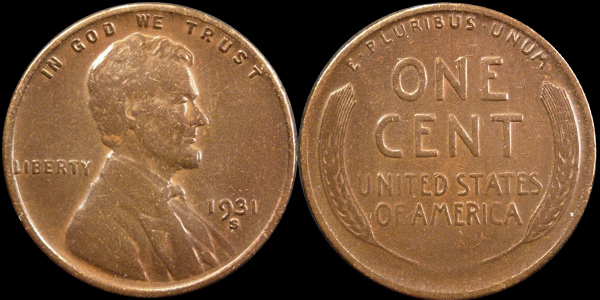
A genuine 1931S cent
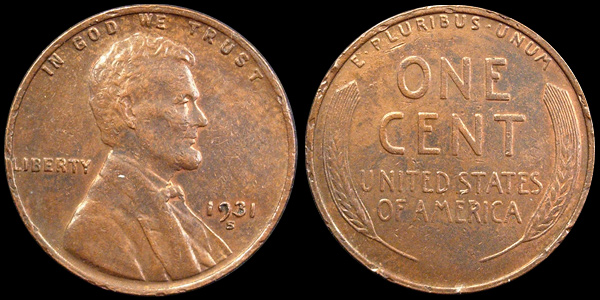
A struck counterfeit 1931S cent
The two images above, when laid out next to one another, show obvious differences between the genuine (top) and counterfeit (bottom) coins. The inside of the rims on the genuine coin ramp downward in profile to the fields creating a bowl-like appearance common with most early 20th century designs. The counterfeit, on the other hand, shows a very sharp inner rim, much like the more recent coin designs. No geniune 1931S cent, regardless of the coin's die state, will exhibit sharp inner rims. The below synopsis and comparison photographs will detail the differences between a genuine coin and the counterfeit specimen studied. As with all such cases, do not use any of the particular markers and/or detailed information to determine whether a coin you may have is counterfeit. Instead, use the general information as a whole in determining the authenticity of your coins.
|
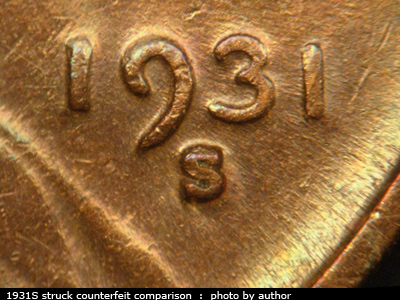
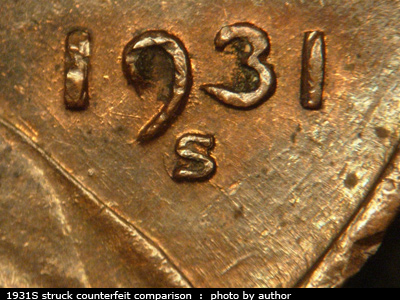
|
The struck counterfeit examined here has normal weight and composition for a Lincoln cent, indicating that this counterfeit was likely struck on a genuine Lincoln cent planchet. Blank planchets are easy to come by. Available in most dealer shops for a couple of dollars, they make perfect blanks for counterfeiters to use. The
first pair of photos shows an immediate problem with the date. The genuine coin (above) shows that the date is actually rather soft on the genuine coins. Although this particular coin is somewhat later in die state, this general rule applies to all cents of this era. The counterfeit (bottom) shows that the counterfeiter(s) had trouble replicating the exact shape and size of the date. The lower extremity of the 3 is too long, and the date is too high in relief and too sharp for a genuine coin. The mintmark is also too small and misshapen.
Another
problem that will be revisited throughout these photographs is that
the rims are too sharp on the inside. A genuine Lincoln cent will exhibit a ramp-like drop-off from the rim into the fields creating a bowl like appearance to the overall coin. This struck counterfeit drops straight off from the rim into the field and is void of the expected bowl-like shape.
|
|
The next image shows that the L of LIBERTY is too close to the rim on the counterfeit (bottom) and that once again the rim is too sharp. Very often it is noted on genuine coins that the L becomes weak along the outer edge and eventually begins to merge with the rim. This counterfeit is an early die state, as evidenced by the sharpness of the letters and the rim. Either this coin was only one of few struck using the counterfeit dies, or is one of the first of many more. This author believes it is one of few struck because 1931S struck counterfeit cents are not at all commonly encountered.
|
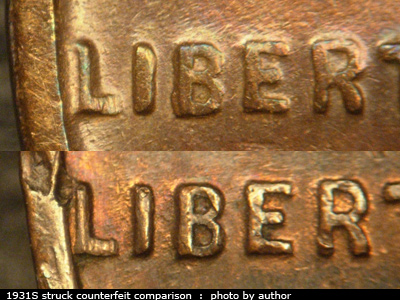
|
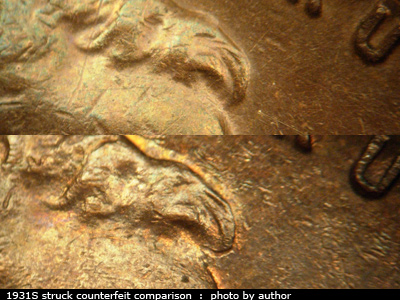
|
An odd curiosity with this counterfeit is that the shape of the front hair is wrong. Note that on the genuine specimen (top) the hair is very round in the front, and the point that meets the forehead is actually pointing slightly downward. The counterfeit (bottom) has a much more teardrop shape to the front hair and has a pronounced upward curve where the hair meets the forehead. This specific design flaw is something that may not be present on other die struck counterfeits, but is pointed out to show that these counterfeits often have tooling marks or other slight design flaws that can be found with patience and a discerning eye.
|
|
The reverse, like the obverse, has a very sharp drop-off line on the inside of the rim on the counterfeit coin (bottom). The genuine coin (top) shows the normal slant downward from the edge of the design inward. Most of the rest of the reverse features are quite indistinguishable from those of a genuine coin. If the counterfeiter(s) had been able to file down the edges of their design to give the reverse that bowl-like feature evident on real Lincoln cents, this reverse could easily have fooled experts.
One of the small features that makes this author believe very few coins were struck with these counterfeit dies shows on the area around the upper left wheat lines. Note the raised bumps in the field. This is indicative of rust or other problems that plagued the steel used for the die, and would likely never be on a genuine coin.
|
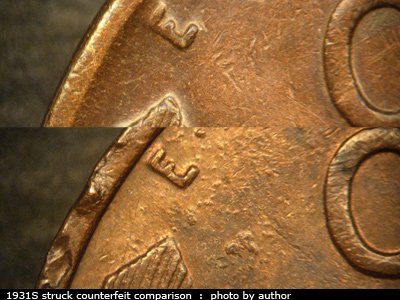
|
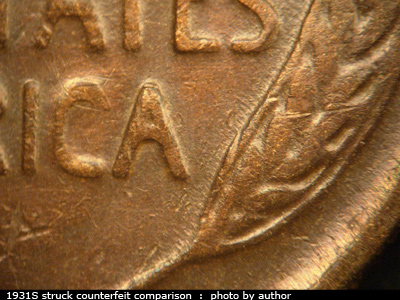
|
The next two photos show the lower right reverse area of the genuine coin (left) and the counterfeit coin (below). Note two things here - sharp and highly distinct details on the counterfeit, and again that very sharp drop-off to the rim. Both are indicative of a counterfeit. Genuine cents from the 20s and 30s often had soft reverse features due to overuse of the hubs and dies. Any coin from this era showing needle sharp features should immediately come into suspect.
Notice
also that even though the details are sharp in this area they are flawed--the outer edges of the letters in AMERICA are bumpy. The grains in the wheat stalk are incomplete or run together. Oddities in design such as these and the hair line mentioned above are always clear signals of a counterfeit.
|
|
The
last feature to cover on this coin is the motto across the top of the reverse (below). While I only show a small portion of this area (the NUM of UNUM), the same rule applies across the entire top of the reverse. On the counterfeit (bottom again) the rim is too sharp, the letters are too thin and sharp, and the letters are too close to the rim.
While this counterfeit is a very good one, it still shows many flaws when examined closely. All struck counterfeit coins do show at least some amount of flaws that can be detected using magnification, genuine comparison pieces, and a bit of patience.
My thanks to Jim Dressler for allowing me the opportunity to examine and photograph the struck counterfeit 1931S cent shown in this article.
|
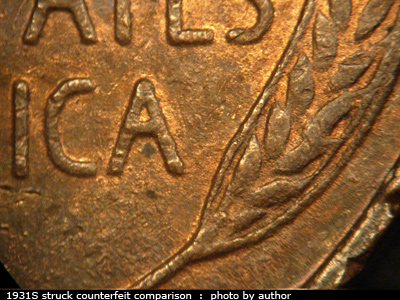
|
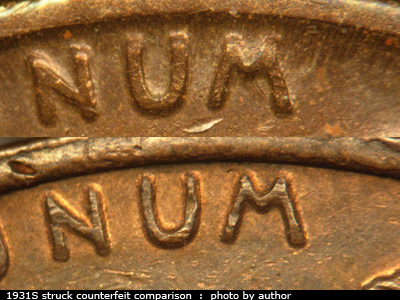
|
Return to the 1931 date guide
|
|
|

